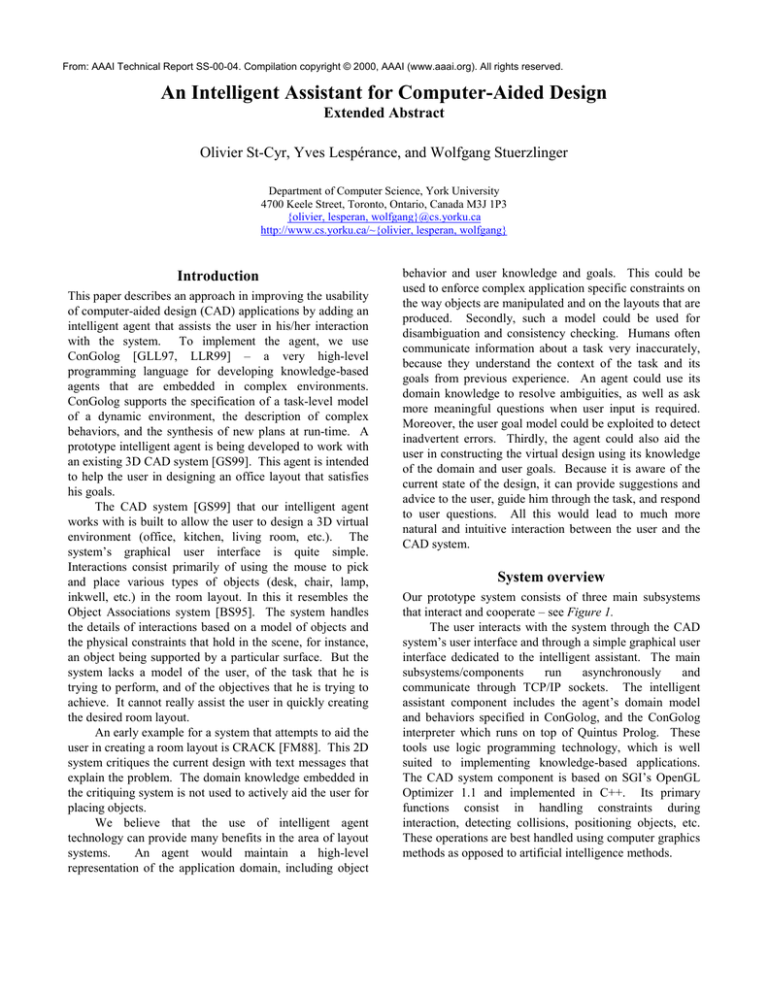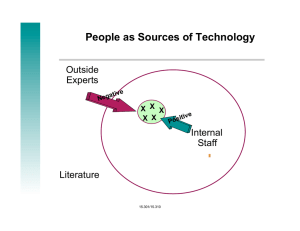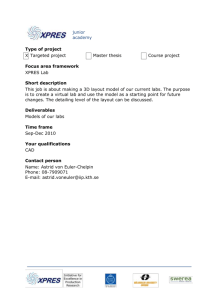
From: AAAI Technical Report SS-00-04. Compilation copyright © 2000, AAAI (www.aaai.org). All rights reserved.
An Intelligent Assistant for Computer-Aided Design
Extended Abstract
Olivier St-Cyr, Yves Lespérance, and Wolfgang Stuerzlinger
Department of Computer Science, York University
4700 Keele Street, Toronto, Ontario, Canada M3J 1P3
{olivier, lesperan, wolfgang}@cs.yorku.ca
http://www.cs.yorku.ca/~{olivier, lesperan, wolfgang}
Introduction
This paper describes an approach in improving the usability
of computer-aided design (CAD) applications by adding an
intelligent agent that assists the user in his/her interaction
with the system. To implement the agent, we use
ConGolog [GLL97, LLR99] – a very high-level
programming language for developing knowledge-based
agents that are embedded in complex environments.
ConGolog supports the specification of a task-level model
of a dynamic environment, the description of complex
behaviors, and the synthesis of new plans at run-time. A
prototype intelligent agent is being developed to work with
an existing 3D CAD system [GS99]. This agent is intended
to help the user in designing an office layout that satisfies
his goals.
The CAD system [GS99] that our intelligent agent
works with is built to allow the user to design a 3D virtual
environment (office, kitchen, living room, etc.). The
system’s graphical user interface is quite simple.
Interactions consist primarily of using the mouse to pick
and place various types of objects (desk, chair, lamp,
inkwell, etc.) in the room layout. In this it resembles the
Object Associations system [BS95]. The system handles
the details of interactions based on a model of objects and
the physical constraints that hold in the scene, for instance,
an object being supported by a particular surface. But the
system lacks a model of the user, of the task that he is
trying to perform, and of the objectives that he is trying to
achieve. It cannot really assist the user in quickly creating
the desired room layout.
An early example for a system that attempts to aid the
user in creating a room layout is CRACK [FM88]. This 2D
system critiques the current design with text messages that
explain the problem. The domain knowledge embedded in
the critiquing system is not used to actively aid the user for
placing objects.
We believe that the use of intelligent agent
technology can provide many benefits in the area of layout
systems.
An agent would maintain a high-level
representation of the application domain, including object
behavior and user knowledge and goals. This could be
used to enforce complex application specific constraints on
the way objects are manipulated and on the layouts that are
produced. Secondly, such a model could be used for
disambiguation and consistency checking. Humans often
communicate information about a task very inaccurately,
because they understand the context of the task and its
goals from previous experience. An agent could use its
domain knowledge to resolve ambiguities, as well as ask
more meaningful questions when user input is required.
Moreover, the user goal model could be exploited to detect
inadvertent errors. Thirdly, the agent could also aid the
user in constructing the virtual design using its knowledge
of the domain and user goals. Because it is aware of the
current state of the design, it can provide suggestions and
advice to the user, guide him through the task, and respond
to user questions. All this would lead to much more
natural and intuitive interaction between the user and the
CAD system.
System overview
Our prototype system consists of three main subsystems
that interact and cooperate – see Figure 1.
The user interacts with the system through the CAD
system’s user interface and through a simple graphical user
interface dedicated to the intelligent assistant. The main
subsystems/components
run
asynchronously
and
communicate through TCP/IP sockets. The intelligent
assistant component includes the agent’s domain model
and behaviors specified in ConGolog, and the ConGolog
interpreter which runs on top of Quintus Prolog. These
tools use logic programming technology, which is well
suited to implementing knowledge-based applications.
The CAD system component is based on SGI’s OpenGL
Optimizer 1.1 and implemented in C++. Its primary
functions consist in handling constraints during
interaction, detecting collisions, positioning objects, etc.
These operations are best handled using computer graphics
methods as opposed to artificial intelligence methods.
User
Agent GUI
TCP/IP socket
CAD
System
Domain
model
- User interface
- Constraint handling
- Collision detection
TCP/IP socket
Intelligent
Assistant
Agent
behaviors
ConGolog
interpreter
- Positioning
- Etc.
Figure 1. System architecture.
The CAD system
Most of today’s CAD systems are well suited to creating
geometric objects. Nevertheless, users find common tasks,
such as quickly furnishing a room, hard to accomplish,
especially since placing objects is conceptually different
from creating them. The IConS CAD system [GS99] used
in this project is a recently developed 3D application that
exploits knowledge about the behavior of objects to
provide simple and intuitive interaction techniques for
object placement and manipulation.
Objects are
represented using polygonal models. The application uses
a simple two-dimensional interface. The main interaction
device is the mouse; keyboard commands are used only for
switching modes and organizational tasks. Currently, three
modes exist: constrained object movement, unconstrained
object movement, and viewer navigation (see [GS99] for
details).
A user of this system builds scenes based on a
predefined library of objects. For each object, two sets of
areas are defined: offer areas and binding areas. These
areas are bound together by constraints and thus, limit the
positioning of the constrained object during manipulation.
Collision detection/avoidance is also used to ensure that no
two objects occupy the same space. These principles
(surface constraints and collision detection/avoidance)
capture part of the natural behavior of objects in the
system. See Figure 2 for an example of a scene.
General geometric constraints are already part of the
IConS system. For example, OnFloor and OnWall are two
of the system’s constraints that can limit where an object
can be placed. All the implemented constraints describe
general placement guidelines for objects that can be used
in any design; they are not specific to the application
domain. This is where a knowledge-based agent could be
useful; it could know for instance, that a computer should
not be placed too close to a heat source.
Figure 2. Picture of a scene.
ConGolog
As mentioned earlier, the intelligent assistant agent is
implemented in ConGolog. ConGolog is an agent
programming language based on techniques for reasoning
about action and implemented using logic programming
technology. Roughly speaking, one can see it as a
concurrent programming language where the primitive
actions are not assignments or arithmetic operations, but
high-level domain–specific actions like “moving a book
onto the desk”. A ConGolog program includes two
components: a specification of the domain and its
dynamics, and a specification of the agent’s behavior. The
domain specification is expressed in a declarative
formalism based on the situation calculus, a logical
language for representing a changing world. It includes
declarations for the primitive actions that can be performed
by the agent or environment in the domain, declarations for
properties of the domain that may change from state to
state (these are called fluents), and specifications of the
preconditions and effects of the primitive actions in terms
of these fluents.
The behavior specification is expressed procedurally
by composing the primitive actions using constructs that
include loops, conditionals, concurrency with possibly
differing priorities, interrupts, and non-deterministic
choice. Behaviors can be complex and the use of domain
specific primitive actions means that the specification can
be very high-level. A model of the state is automatically
maintained by the interpreter based on the domain
specification and programs can refer to it by testing
conditions expressed in terms of the abstract fluents. The
availability of concurrent processes and interrupts
facilitates the implementation of agent controllers that
monitor and react to changes in their environment while
pursuing goal-oriented tasks. Plan synthesis can be
performed using non-deterministic search. ConGolog has
been used to implement various types of agents including a
robot controller [LTJ00] and a meeting-scheduling
assistant [LLR99]. Funge [Fu98] has also used a subset of
ConGolog to produce more natural computer animations.
The intelligent assistant agent
Domain representation
In the office layout domain, there are many types of
objects. These are organized into a hierarchy of classes,
e.g. Desk, InkWell, etc.
These object classes are
themselves instances of a set of function-related
metaclasses:
•
•
•
•
WorkspaceAreaObjectClass, which includes
Desk, Chair, SideTable, etc.
MeetingAreaObjectClass, which includes
MeetingTable, Chair, WhiteBoard, etc.
StorageAreaObjectClass, which includes Bookshelf,
Book, FilingCabinet, etc.
OfficeEquipmentAreaObjectClass, which includes
FaxMachine, Printer, Photocopier, etc.
Spatial relation types (e.g. OnTop, On Floor,
OnWorkspace, etc) are also grouped in a hierarchy. There
are primitive actions for creating and destroying an
instance of an object or relation class.
Another set of fluents and primitive actions is used to
represent interactions with the user or the CAD module.
For example, the agent can perform the primitive action
makeYesNoQuery(msg) and a possible response of the user
is
represented
by
the
primitive
action
answerYesNoQueryYes.
The declarations for the
makeYesNoQuery(msg) are:
// preconditions
Action makeYesNoQuery(msg)
possible when ¬ YesNoQueryOut.
// effects
Occurrence makeYesNoQuery(msg)
causes YesNoQueryOut always.
choose c, o, s , s2, s3 : [
setOf(c, AccessoriesClass(c), s1)?;
remove(o, ¬ LegalRelation(OnWorkspace,
Desk,o), s1, s2)?;
append(s2, [ "None of the above"], s3)?;
makeMenuQuery("Please pick an accessory", s3)]
Another area where ConGolog helps is in detecting
errors and constraint violations. The agent can easily
check the legality of the actions requested by the user
before performing them. For example, if the user
requested the agent to place a computer on top of a heater,
it could detect that creating an instance of the OnTop
relation between these was illegal. In such situations, it
could also suggest alternative actions that may achieve the
user’s goal. ConGolog’s plan synthesis facilities could
also be useful for dealing with unanticipated user requests,
recovering from failures, or producing animations.
Future work
These declarations are used by ConGolog to initialize the
agent’s knowledge base, update it when actions occur, and
check the legality of actions in a given state.
Agent behavior specification
So far the behaviors that have been scripted for the agent
are rather simple. For e.g., the procedure, which interacts
with the user to help him set up the workspace area of his
office layout, goes as follows:
proc setUpWorkSpace(officeLayout) [
addObj(Desk,officeLayout);
addObj(Chair,officeLayout);
resetYesNoQuery;
makeYesNoQuery("Would you
like to have one more chair
added to your office?");
yesNoQueryRespIn?;
if yesNoQueryAnsYes then
addObj(Chair,officeLayout));
…
endProc
As we extend the agent’s behavior, we hope to exploit
the distinctive features of ConGolog.
For instance,
ConGolog makes it easy to use the knowledge base to
generate alternatives that satisfy some conditions. As an
example, let’s assume that the user had just added a desk
into his office layout and wanted to add some accessories
to it. The agent could produce a menu of alternatives as
follows:
A simple version of the agent module has been
implemented and testing has shown that it can be used to
create simple layouts in a straightforward manner. This
agent module is now being connected to the IConS CAD
system. We are also continuing to develop the ConGolog
representation of the domain and extending the behavior of
the agent. Our objectives are to demonstrate the feasibility
of the approach and document its advantages over standard
techniques.
References
[BS95] Bukowski, R., and Sequin, C. 1995. Object
Associations: A Simple and Practical Approach to Virtual
3D Manipulation, ACM Symposium on Interactive 3D
Graphics ’95, 131-138, Monterey, CA.
[Fu98] Funge, J. 1998. Making Them Behave: Cognitive
Models for Computer Animation, Ph.D. Thesis, University
of Toronto, Toronto, Canada.
[FM88] Fischer G. and Morch A. 1988. CRACK: A
Critiquing Approach to Cooperative Kitchen Design. In
Proceedings of the International Conference on Intelligent
Tutoring Systems, 176-185, Montreal, Canada.
[GLL97] De Giacomo, G., Lespérance, Y., and Levesque,
H. J. 1997. Reasoning about Concurrent Execution,
Prioritized Interrupts, and Exogenous Actions in the
Situation Calculus. In Proceedings of the Fifteenth
International Joint Conference on Artificial Intelligence,
1221-1226. Nagoya, Japan.
[GS99] Goesele, M., and Stuerzlinger, W. 1999. Semantic
Constraints for Scene Manipulation. In Proceedings of the
Spring Conference in Computer Graphics, 140-146.
Budmerice, Slovak Republic.
[LLR99] Lespérance, Y., Levesque, H. J., and Reiter, R.
1999. A Situation Calculus Approach to Modeling and
Programming Agents. In Wooldridge, M., and Rao, A.,
editors, Foundations of Rational Agency, 275-299. Kluwer.
[LTJ00] Lespérance, Y., Tam, K., and Jenkin, M. 2000.
Reactivity in a Logic-Based Robot Programming
Framework, to appear in Jennings, N.R. and Lespérance,
Y., editors, Intelligent Agents Volume VI - Proceedings of
the 1999 Workshop on Agent Theories, Architectures, and
Languages (ATAL-99), LNAI, Springer-Verlag, Berlin.








